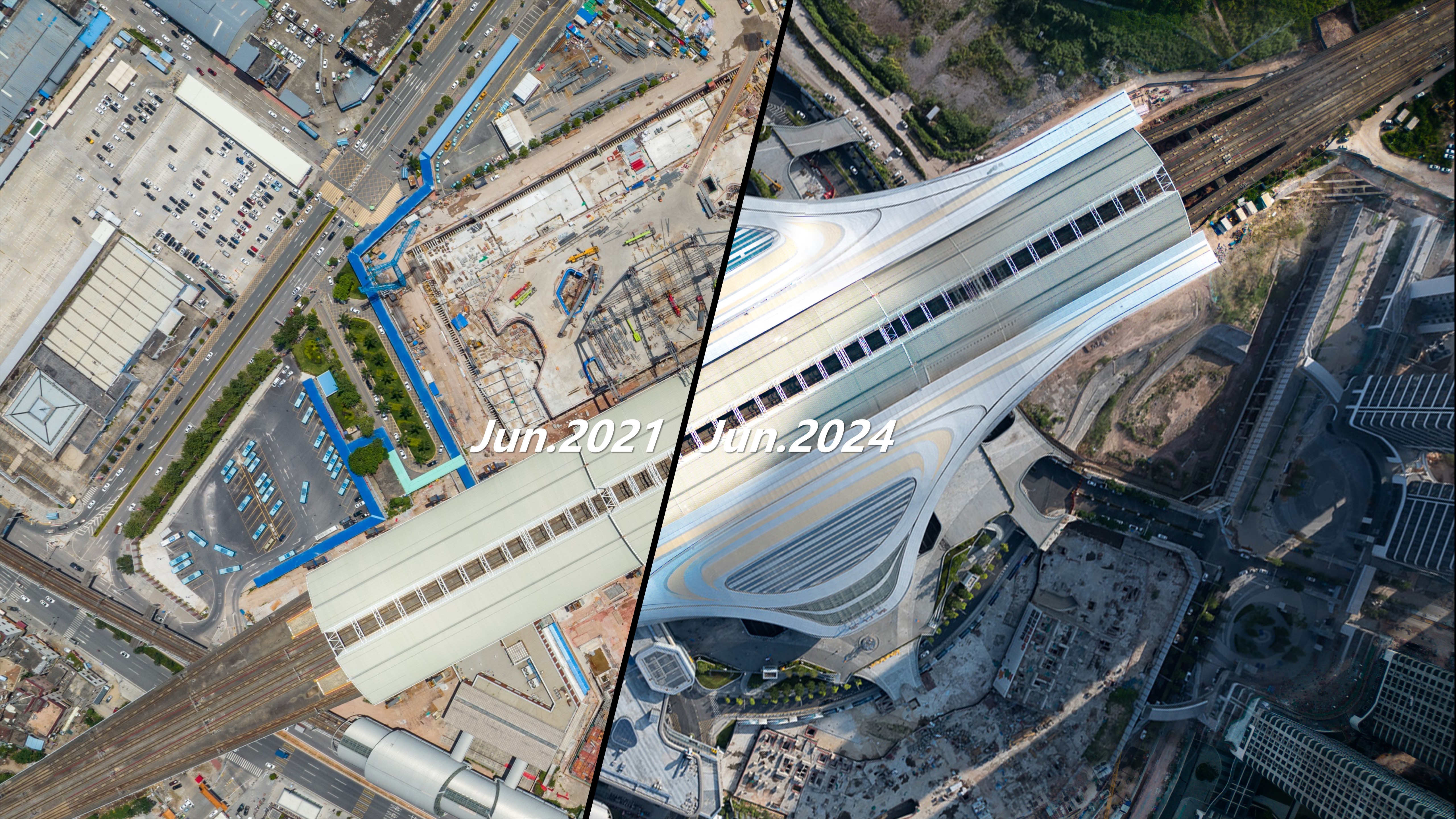
枢纽总体设计 铁四院、Aedas
站房建筑设计 Aedas
项目位置 广东东莞
竣工年份 2023年
建筑面积 枢纽EPC部分155,382.87平方米
本文文字由Aedas提供。
近期,由Aedas与铁四院一道操刀设计的东莞虎门站高铁枢纽改扩建工程的站房工程交付启用迎来一周年。虎门站是继香港西九龙高铁总站之后,Aedas在广深港高铁客运专线上的又一力作,在整个大湾区范围内客流规模位列第三。这座全新的建筑不仅标志着虎门站由传统的铁路车站升级为功能完备的综合交通枢纽,更是展示东莞城市发展的重要窗口。
Led by Aedas Executive Director Leon Liang, Dongguan Humen High-Speed Railway Station expansion project exemplifies Aedas TOD expertise, showcasing the dynamic growth and vigor of Dongguan as an emerging first-tier city. The integrated transportation hub serves as a vital node in South China’s transportation network and sets a standard for TOD in the new era.
▲ 项目视频 ©Aedas
随着近年东莞城市能级的提升和虎门站客流的日益增大,原单一的铁路站亟需转型为集各种功能的综合枢纽。作为大湾区内首个对运营中的高铁站进行不停运的彻底改扩建升级的项目,如何既要维持施工期铁路的运营需求,又要对枢纽候车空间、换乘流线进行高标准现代化的改造,是设计面临的首要任务。史无前例,Aedas受业主委托,为虎门站TOD综合开发提供由城市设计到单体建筑设计的全过程服务。
Due to Dongguan’s rapid urban development and increasing traffic at Humen Station, the original station required an urgent need to transform into a multimodal TOD hub. The project involved expanding and renovating the high-speed railway station, integrating the hub with the city while ensuring continuous railway operations during construction.

Aedas项目团队主管梁志华介绍道:“虎门新站要呈现东莞近年城市发展、积极融入大湾区建设的成效。”因此,设计团队提出了“如虎添翼”的建筑构想:保存老站房与站台以确保施工期间铁路站房的正常运营,在南北两侧扩建增添一对“银翼”覆盖新候车厅与城市公共空间。“银翼”遮挡高架站台同时,塑造更人性化的站城建筑界面。舒展的建筑形态,也是广场与换乘线路的顶盖,如同展开的双翅为往来的乘客遮风挡雨。
“Our goal is not only to shape a unique urban landmark for Humen but also symbolises the achievements of Dongguan’s development,” Leon explained. The team introduced the concept of ‘Tiger with wings’. A pair of ‘silver wings’ was added on the north and south sides to envelop the new waiting hall and public spaces and foster a more humanised station-city architectural interface. The design functions as a canopy over the plaza and transfer routes, mimicking spread wings that shelter passengers.

整个站房顶盖立面设计应用极简主义美学,通过对材料的有序编排,将复杂的接缝优化为清晰的线条,勾勒出建筑动态腾飞的曲线。“银翼”下方巨大的Y型柱承载了大部分顶盖重量,从而减少了位于候车大厅室内的巨柱数量和尺寸,不仅为旅客提供了更宽敞、灵活的候车空间,“翼身融合”的结构设计更是充分展现了腾飞羽翼的力量感。
The roof façade design applies minimalist aesthetics, transforming complex seams into sleek lines through strategic material arrangement, creating dynamic curves. The large Y-shaped columns beneath the ‘silver wings’ support the roof and reduce the need for large columns in the waiting hall, providing passengers with more spacious and flexible waiting spaces.

南北侧“银翼”覆盖下的是本次新扩建的候车大厅。与老站房相比,新站房候车厅面积达11440平方米,闸机数量达20个,可容纳5000名旅客同时候车。巨型的采光天窗、柔和的白色遮阳膜、白色波浪型的背景墙,都凸显了新时代设计对自然光的驾驭,成就温馨惬意的光影大厅。
遮阳软膜与穿孔内饰设计不仅是时尚材料的运用,更是大人流聚集空间中控制声学品质的重要措施,是保障旅客在站内停留等候的舒适体验必要考量。站房入口通高的玻璃墙,映出候车厅内造型时尚的大型数字时钟,形成强烈的视觉冲击力,营造出富有未来科技感的站内空间。
The new station’s waiting hall spans over 11,440 sq m with 20 ticket gates, accommodating up to 5,000 passengers waiting simultaneously. Giant skylights, soft sunshades, and wave-like walls create a cozy hall filled with light and shadows. The sunshade membranes and porous interior design control sound volume in crowded areas, ensuring a pleasant experience for passengers. The towering glass walls at the main entrance reflect a stylish digital clock, adding a striking futuristic visual effect.



广深港高铁、穗莞深城际轨道、东莞轨道2号线在虎门站交汇,多种公共出行方式在此换乘,使其成为东莞市域内客流条件最复杂、流线最多种的大型综合交通枢纽。而大型枢纽内复杂的标识往往给旅客出行造成一定负担,因此,用具有识别性的建筑空间实现对旅客“自然而然的引导”是设计团队的目标。
设计以“城市换乘客厅”的概念,将位于平台上的高铁站、地铁站与地面公交枢纽和地下的城际站通过中庭垂直整合,空间内的商业配套、旅客问询服务等功能配合上高效的自动扶梯,在自然光的引导下,带给旅客舒适的出行换乘体验。
The Humen Station serves as a convergence point for the Guangzhou-Shenzhen-Hong Kong High-speed Rail, the Guangzhou-Dongguan-Shenzhen Intercity Rail, and the Dongguan Rail Line 2, facilitating seamless connections. The design incorporates ‘natural guidance’ through simple spatial arrangements to minimise the need for complex signage. The ‘urban transfer hall’ integrates high-speed rail and subway stations with a bus terminus and underground intercity station via a central atrium. It includes commercial facilities, inquiry services, and escalators, offering a comfortable transfer experience guided by natural light.


此外,设计在原地面一层之上布局了一个二层大板作为城市露台,一改铁路站前广场仅作为旅客进出站的集散功能,将其转换为通过慢行体系的引力场,构建一个展现东莞城市发展、精神文化的舞台。
Above the ground floor, a two-storey urban terrace transforms the railway station front square into a vibrant urban space through a pedestrian path, showcasing Dongguan’s urban development and cultural essence, adding a dynamic element to the station.

露台遮盖之下,一层由原候车室功能转变为一个公交枢纽和公共停车的场所,汽车可以开到车站站体下方,实现人车分流,从而充分激活公交枢纽和地下停车场等灰色交通设施,消除了大流量交通对城市的割裂。
The ground floor under the terrace serves as a public transport interchange and parking area. Vehicles can drive under the station. The design creates a clear separation between pedestrian and vehicular traffic, eliminating the impacts of high-volume traffic.

梁志华对项目总结道:“随着如今国家八横八纵的高铁网络已经搭建起来,城际网络更高效,TOD已然成为城市一体化发展的新趋势。我们希望它不仅可以成为效率的代表,也可以成为城市人本精神的代言。”
“With the current establishment of the national high-speed rail network, intercity connections have become more efficient. TOD has emerged as a new trend in urban development. We hope that it will not only be a bustling transit station but also a city’s community space that captivates visitors, allowing them to pause, stay and savor life,” Leon said.

完整项目信息
项目:东莞虎门站高铁枢纽改扩建工程
位置:中国东莞
设计建筑师:Aedas
业主:东莞市轨道交通局、虎门镇人民政府、东莞国铁保利实业发展有限公司
建筑面积:枢纽EPC部分155,382.87平方米
竣工年份:2023年
Aedas项目团队主管:梁志华,执行董事
联合体构成
站城一体城市设计:Aedas
EPC工程设计总承包:铁四院
枢纽总体设计:铁四院、Aedas
站房建筑设计:Aedas
规划修编:东莞市规划院
结构顾问:Arup
交通顾问:MVA
景观设计:Aecom
室内设计:C-Rtkl
幕墙设计:RFR
版权声明:本文由Aedas授权发布。欢迎转发,禁止以有方编辑版本转载。
投稿邮箱:media@archiposition.com
上一篇:NBBJ+北京建院新作:阿里巴巴北京朝阳科技园,“3X”互联体
下一篇:杭州中心四季酒店:水上绮梦 / Avalon Collective